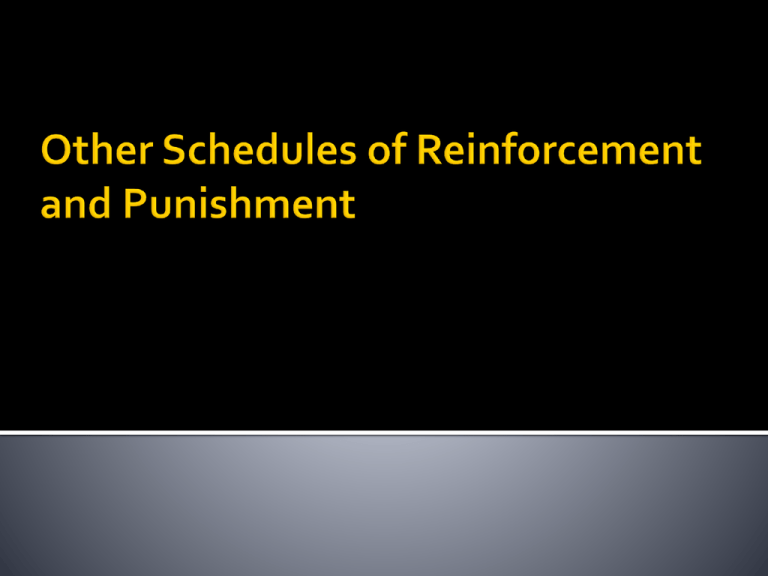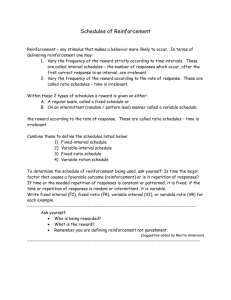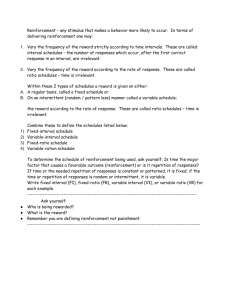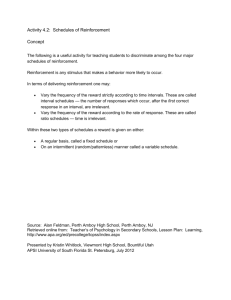Other Schedules of Reinforcement and Punishment
advertisement

Also called Differentiation or IRT schedules. Usually used with reinforcement Used where the reinforcer depends BOTH on time and the number of reinforcers. Provides an intervention for behavior problems associated with rate of response. Can be very effective in producing or reducing behavior. Is the time that occurs between two responses IRT and rate of responding are functionally related Long IRT schedules produce low rates of responding Short IRT schedules produce high rates of responding Have to respond at a high rate within a certain amount of time. Examples 1. Need to complete 25 math problems within 30 minutes You work your tail off to get them done and receive recess for 15 minutes 2. Must sell 15 car in the next 10 days Work hard, get them sold and receive a $15,000 bonus Is very effective - Get very high rates of responding. Full Session DRH Provides reinforcement if the total number of responses during the session meets or exceeds a number criterion across the entire session Interval Session DRH Reinforcement is available only for responses that over during short periods of time during the session. (Get additional bonuses during the 10 day session) Cannot make the level to high If the organism does not respond enough, it will receive less reward and ultimately decrease their response rate. Sell 25 cars in 10 days Responding looks like an FI schedule. Work hard, get cars sold, then you take a break. Sometimes referred to as Spaced-Responding DRH or Spaceresponding DRL Is designed to create low levels of responding during a particular time period. A period of time must elapse with few or responses of the undesired behavior. (Number of responses is defined by the schedule) E.g., Don’t want a child to act out in class. Give the kid a reinforcer when acting out responses are low during a particular time period. Will give low rates of responding. Full Session DRL Provides reinforcement if the total number of responses during the entire session is at or below some level Interval Session DRL Reinforcement is available only for lack of responding during short intervals of time during the entire session Works well in applied settings. Schools Group homes Other Provide reinforcement only in the absence of a response in a specified period of time No acting out for the next hour and you get 15 minutes of recess. Is similar to DRO Inappropriate behavior is replaced by reinforcing alternative behaviors Decreases inappropriate behavior Also similar to DRO Reinforce a behavior that is incompatile with the targeted behavior Reduce out of seat behavior by reinforcing in seat behavior Cannot make the schedule to thin initially If the organism cannot get reinforced, may not get the desired response May get alternative reinforcement for others Systematically thins each successive reinforcement opportunity independent of the participant’s behavior. ▪ Progressive Ratio Schedules of Reinforcement (PR) ▪ Progressive Interval Schedules of Reinforcement (PI) Systematically increase the ratio or interval requirements for reinforcement Similar to a DRL schedule Get reinforced for the lack of responding over a period of time Reinforced for only 5 outbursts in 30 minutes Then reinforced for only 4 outbursts in 30 minutes Etc. Combine elements of continuous, intermittent, or differential reinforcement Requires the participant to choose between two or more stimuli Arranging two or more reinforcers for the participant to choose from contingent upon the occurrence of a target behavior. Rate of responding typically is proportional to the rate of reinforcement received from each choice alternative. Concurrent interval schedules – participants typically do not allocate all of their responses exclusively to the richer schedule. Concurrent ratio schedules – participants are sensitive to the ratio schedules an tend to maximize reinforcement by responding primarily to the ratio that produces the higher rate of reinforcement. Presents two or more basic schedules of reinforcement in an alternating, usually random, sequence. Basic schedules occur successively and independently. A discriminative stimulus is correlated with each basic schedule and is present as long as the schedule is in effect Mixed Schedules (mix) Identical to multiple schedules, except the mixed schedule has no discriminative stimuli correlated with the independent schedules Example: mix FR 10 FI 1 schedule Need to monitor the behavior and develop a baseline Implement the intervention based on some particular schedule Monitor the outcome and determine if the behavior has changed. If not, examine the behavior If the behavior changes, after the behavior is stable, change the schedule Do not change until the behavior is stable Lots of schedules Make sure you understand them Consider the schedule BEFORE you begin planning your intervention When will you change it, how will you thin it, etc.






